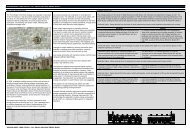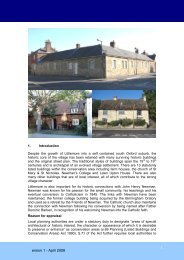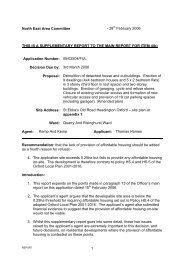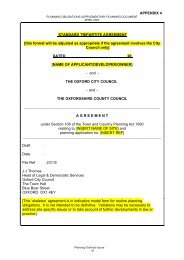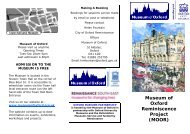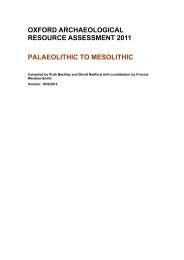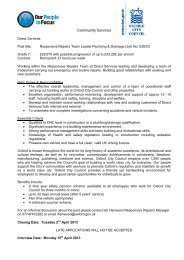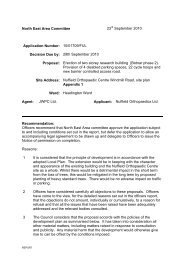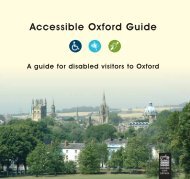Post-medieval Oxford - Oxford City Council
Post-medieval Oxford - Oxford City Council
Post-medieval Oxford - Oxford City Council
Create successful ePaper yourself
Turn your PDF publications into a flip-book with our unique Google optimized e-Paper software.
Rural settlement: the pattern of settlement in the parishes around <strong>Oxford</strong> also<br />
saw some change as some villages expanded, new areas of settlement become<br />
important such as at Headington Quarry while others were absorbed into the city<br />
(Worcester Street) or disappeared completely (Wyke).<br />
The Civil War Defences: <strong>Oxford</strong> was the Royalist capital during the Civil War and<br />
was heavily defended with two phases of earthworks and re-worked sections of<br />
the <strong>medieval</strong> city defences. However, the full character and extent of these<br />
works, and the related Parliamentarian siege line, are not understood.<br />
Notable post-<strong>medieval</strong> buildings and structures (excluding colleges buildings)<br />
Parts of the inner defensive bank of the royalist defensive line 1644-46 survive<br />
north east of the town.<br />
Carfax Conduit survives at Nuneham Courtney.<br />
Several notable post-<strong>medieval</strong> Parks and Gardens include the Grade 1 17th<br />
century Botanic Garden.<br />
18th century cobbles survive in Merton Street (Cobbles).<br />
17th century Iffley Lock.<br />
Historic inns in Cornmarket and High Street.<br />
Groups of town houses in High Street and Pembroke Street.<br />
Groups of suburban houses in Holywell, St Michael’s Street, Ship Street, Broad<br />
Street and St Giles.<br />
18th-century buildings of <strong>Oxford</strong> prison.<br />
All Saints Church.<br />
The Old Bodleian.<br />
The Radcliffe Infirmary.<br />
The Radcliffe Observatory.<br />
The 17th century Danby Arch, Botanic Garden.<br />
The University Convocation House.<br />
The Bodleian Library and the Schools Quadrangle.<br />
The Sheldonian Theatre.<br />
The Old Clarendon Building.<br />
The Old Ashmolean Building.<br />
The Radcliffe Camera.<br />
Holywell Music Room.<br />
University Real Tennis Courts.<br />
Notable archaeological investigations for the post-<strong>medieval</strong> period:<br />
Material culture:<br />
o Bodleian Library Extension, Clarendon Quadrangle – early recovery of post<strong>medieval</strong><br />
pottery assemblage (Recorded Observation)<br />
o <strong>Oxford</strong> wine bottle sequence (from tavern records) (museum investigation)<br />
OXFORD ARCHAEOLOGICAL RESOURCE ASSESSMENT- POST MEDIEVAL<br />
7



